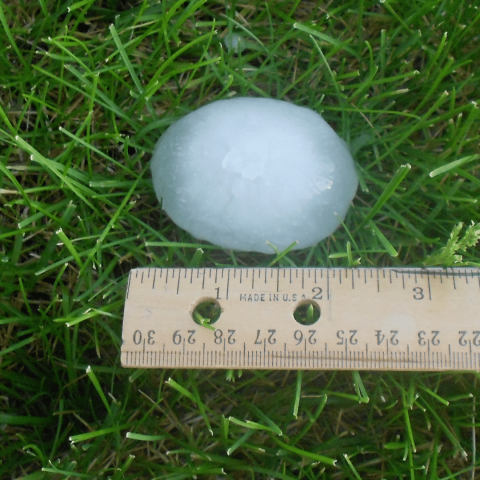Living in an area prone to hail storms like Colorado can be a concern for homeowners, as these natural events can cause significant damage to roofs and lead to costly repairs. Selecting the right hail-resistant roofing is paramount for protecting your home. With numerous options available, making an informed decision might feel overwhelming.
When seeking hail-resistant roofing, focus on impact ratings, local climate demands, and the interplay of costs and insurance incentives. These factors, meticulously examined, empower you to make a resolute decision that safeguards your home and budget.
Understanding Hail and Its Effects on Roofs
Hailstorms can wreak havoc on roofs, leaving homeowners with costly repairs and insurance claims. To better protect your home, it’s crucial to understand how hail forms and its effects on roofing materials. Hailstones are balls of ice that form in severe thunderstorms with strong updrafts. The hail size can range from small pea-sized pellets to large golf balls or even softball-sized chunks. When these icy projectiles strike your roof, they can cause various types of hail damage, including:
- Dents and Bruises: The impact of hail can create dents and bruises on asphalt shingles, metal panels, and synthetic polymers.
- Cracks and Fractures: Hail can crack and fracture roofing materials, leading to water leaks and structural issues over time.
- Granule Loss: On asphalt shingles, hail can strip away protective granules, exposing the underlying layers to the elements.
The Best Hail-Resistant Roofing Materials
While no roof is entirely “hail-resistant,” certain materials offer better resistance against hail damage. Here are the top hail-resistant roofing options:
- Asphalt Shingles are widely available and cost-effective, often available with enhanced impact-resistant variants. However, their impact resistance is moderate when compared to other alternatives.
- Metal Roofing, known for its durability, boasts excellent hail resistance along with a long lifespan and minimal maintenance requirements, though it involves a higher upfront investment.
- Synthetic Polymers, like rubber and plastic, provide high impact resistance and flexibility, coupled with eco-friendly options, yet they tend to come at a higher cost compared to traditional asphalt shingles. Careful consideration of these options empowers homeowners to select the most suitable hail-resistant roofing for their needs.
Factors to Consider When Choosing Hail-Resistant Roofing
Selecting the right hail-resistant roofing involves considering several crucial factors:
- Impact Ratings and Testing Standards
When it comes to ensuring the durability and hail resistance of your roofing material, understanding impact ratings and testing standards is paramount. These metrics serve as a litmus test for a material’s ability to withstand the force of hail impact effectively.
UL 2218 and FM 4473 are two widely recognized standards in the industry. The UL 2218 standard involves subjecting roofing materials to controlled impact tests, simulating the force of hailstones. The material is graded on a scale of Class 1 to 4, with Class 4 representing the highest level of impact resistance.
Similarly, FM 4473 employs a rigorous test protocol to assess roofing material performance under simulated hail impact conditions. A Class 3 or 4 rating from this test signifies superior hail resistance.
When choosing hail-resistant roofing, materials that conform to these standards offer a tangible advantage. They have been rigorously tested and proven to exhibit an elevated level of hail resistance, promising better protection for your home against one of nature’s most formidable elements.
- Local Climate and Hail Frequency
Evaluate your region’s hail risk and frequency. If you live in an area prone to severe hailstorms, investing in hail-resistant roofing becomes even more critical.
In areas like Colorado, where hailstorms are not only frequent but also severe, the significance of investing in hail-resistant roofing is magnified. By opting for materials specifically designed to withstand hail impact, homeowners can safeguard their properties from potentially devastating damage. In such regions, hail-resistant roofing is not merely a choice—it’s a proactive strategy to fortify your home against the elements and ensure its longevity.
- Cost and Insurance Considerations
When deliberating on hail-resistant roofing options, factoring in both the initial cost and potential long-term savings is a prudent approach. While it’s true that hail-resistant roofing materials may involve a higher upfront investment, this cost is often outweighed by the advantages they offer over time.
Consider the scenario of a severe hailstorm hitting an area with non-hail-resistant roofing. The resulting damage could lead to substantial repair expenses, including not only fixing the roof but also addressing potential interior damage caused by leaks. hail-resistant roofing, by contrast, is designed to minimize such damage, effectively reducing the need for frequent repairs and associated costs.
What’s more, many insurance providers recognize the value of hail-resistant roofs in mitigating damage. As a result, they often extend discounts on insurance premiums for homeowners with such roofs in place. This not only serves as a financial incentive but also contributes to further offsetting the initial investment in hail-resistant roofing.
Maintenance Tips for Prolonging Hail-Resistant Roof Lifespan
Ensuring the longevity of your hail-resistant roofing requires consistent maintenance. Here’s a rundown of essential practices:
- Regular Roof Inspections
Commit to periodic roof inspections, ideally conducted by experienced professionals like Just Roofs and Gutters. These inspections unearth potential problems in their early stages, allowing for timely interventions. By promptly addressing issues, you prevent them from escalating into larger, more costly complications.
- Gutter and Downspout Maintenance
Undertake routine maintenance of your gutters and downspouts. Clear any debris to guarantee proper drainage. Efficient drainage prevents water from pooling on your roof, which could otherwise lead to deterioration over time. This simple step significantly contributes to maintaining the structural integrity of your hail-resistant roof.
- Quick Repairs for Hail Damage
Should your hail-resistant roofing experience damage from a hailstorm, swift action is key. As soon as the weather clears, conduct a thorough inspection to identify any impact points. Address these areas promptly to prevent water infiltration, which can result in more extensive problems such as leaks and compromised insulation. By nipping hail damage in the bud, you safeguard the continued effectiveness of your roof’s hail-resistant features.
Implementing these maintenance practices not only extends the lifespan of your hail-resistant roofing but also ensures that it remains fully functional in its ability to withstand future hail events. A well-maintained roof stands as a reliable shield for your home against the forces of nature.
Hail Damage Insurance Claims and Roof Warranties
When confronted with the unfortunate occurrence of hail damage, having a solid grasp of both the insurance claim process and roof warranties becomes imperative:
- Understanding the Insurance Claim Process
In the wake of hail damage, prompt action is pivotal. The first step is to promptly notify your insurance provider about the incident. Accompany this with thorough documentation of the hail damage. Photographs and detailed notes can go a long way in substantiating your claim. This meticulous approach not only streamlines the claims process but also ensures you receive the appropriate compensation for the incurred damage.
- Roofing Manufacturer Warranties
As you contemplate hail-resistant roofing solutions, it’s equally important to delve into the warranties offered by roofing manufacturers. These warranties can vary significantly in terms of coverage and duration. Familiarize yourself with the specifics of the warranty associated with your chosen roofing material. Understand what scenarios are covered and what might void the warranty. This awareness empowers you to make an informed decision, safeguarding your investment in a hail-resistant roof.
Navigating hail damage and its aftermath demands both a proactive approach and a comprehensive understanding of your rights and protections. By being well-versed in the insurance claim process and roofing warranties, you can ensure a smoother recovery journey should hail strike.
Are hail-resistant roofs worth the investment?
Absolutely! Investing in hail-resistant roofs is a smart decision for homeowners living in hail-prone regions like Colorado. While no roof can guarantee complete hail protection, hail-resistant materials like metal roofing, synthetic polymers, and impact-resistant asphalt shingles offer a higher level of durability and protection against hail damage. These roofs can save you from costly repairs and insurance claims in the long run, making them well worth the initial investment.
Upgrade your roof with hail-resistant materials and shield your home from hail damage! Invest in impact-resistant shingles, metal roofing, or synthetic slate for ultimate protection. Schedule a roofing inspection today with Just Roofs and Gutters to ensure you choose the best hail-resistant roofing and prepare your home for any hailstorm! Safeguard your family and property.




